NEW LEGUME SPECIES HIGHLIGHTS 2024
Colin Hughes (University of Zurich, Switzerland)
This is the fifth year that a selection of the new legume species published during the year has been highlighted in the Bean Bag. Over that period (2020–2024), between 50 and 100 new legume species and 30 and 200 new name combinations have been published each year. Thus, significant numbers of new legume species continue to be described across the world every year with no indication of any decline, and 2024 is no exception. Indeed, with more than 100 new legume species described during 2024, this is a bumper year for legume novelties.
This year’s cohort of new legume species includes several examples of species being described based on splitting previously morphologically variable species complexes into multiple segregate species and/or upranking infraspecific taxa as distinct species. This is a trend that is likely to expand in the future as more detailed species-level phylogenies densely sampling all species and intraspecific diversity are assembled and will likely power the ongoing growth in legume species numbers for some time to come.
Alexa duckeana: A New Species from the Brazilian Amazon
The large actinomorphic or near-actinomorphic flowers of species of the genus Alexa would not, at first sight, suggest a Papilionoid legume, which mostly have zygomorphic keel flowers. However, radially symmetric flowers occur in a set of phylogenetically scattered lineages across subfamily Papilionoideae, including the genus Alexa. With nine species, the genus Alexa is distributed mainly in ‘terra firme’ forests across the Amazon basin in South America. This new species, Alexa duckeana, is endemic to the State of Pará in Brazil. It has all the characteristics of the genus Alexa—tree habit, large, actinomorphic, probably bat-pollinated flowers, an enlarged coriaceous campanulate brown calyx, white petals, and large woody pods.
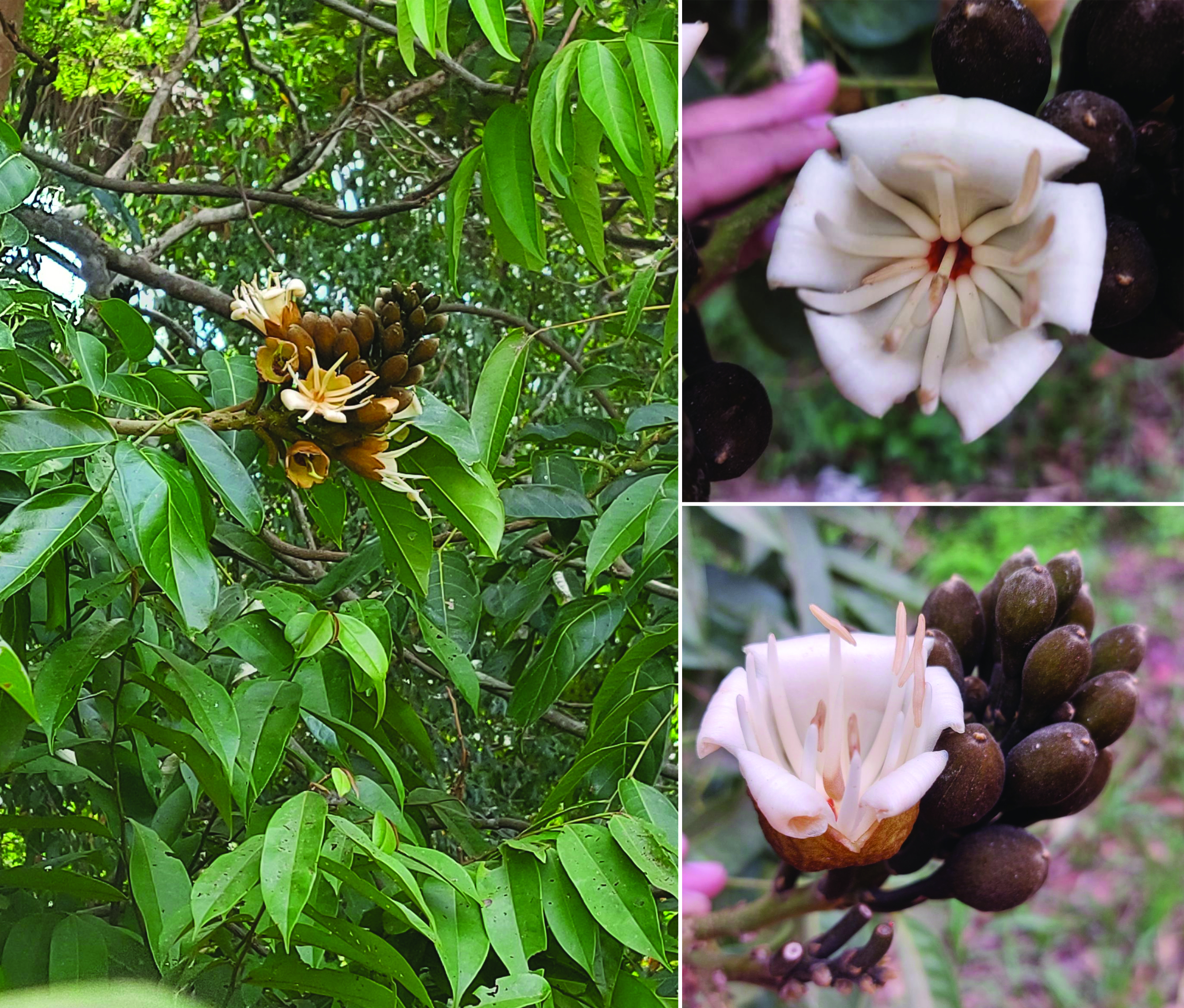 Flowers and foliage of Alexa duckeana; photos by Guilherme Silva.
Flowers and foliage of Alexa duckeana; photos by Guilherme Silva.
Da Silva G.S., Torke B.M. & Mansano V.D.F. 2023. Alexa duckeana (Leguminosae-Papilionoideae): a new species from the Brazilian Amazon. Phytotaxa 629: 255-265. https://doi.org/10.11646/phytotaxa.629.3.7
A New and Critically Endangered Rattlepod (Crotalaria) from Tropical China
Xishuangbanna Prefecture, in SW Yunnan Province of China, bordering Myanmar and Laos, home to the new species of Crotalaria, C. menglaensis, lies within a poorly-known biodiversity hotspot threatened by deforestation and the establishment of rubber plantations. Like many newly described species, C. menglaensis is categorized as Critically Endangered because it is globally extremely rare. Named for the type locality, Mengla County, where it is narrowly endemic, C. menglaensis is known from just a single locality with a handful of populations totaling fewer than 100 adult individuals. Species delimitation was based on detailed morphometric and phylogenetic evidence and adds to the already prodigious diversity in the genus Crotalaria, which comprises >700 species worldwide.
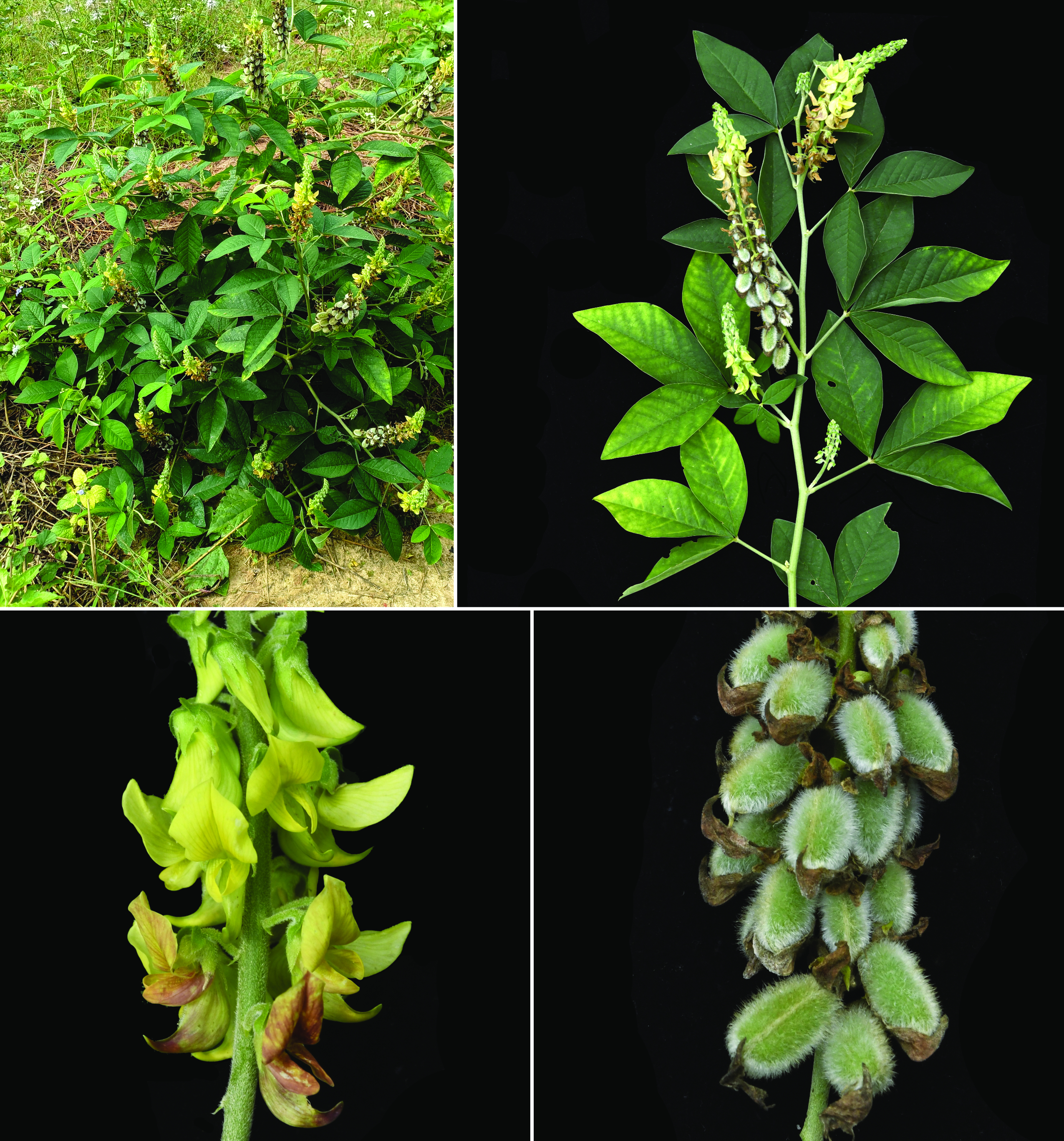 Crotalaria menglaensis; photos by Shabir Ahmad Rather.
Crotalaria menglaensis; photos by Shabir Ahmad Rather.
Rather S.A., Radbouchoom S., Wang K., Xiao Y., Liu H. & Schneider H. 2024. Molecular, morphological, and morphometric evidence reveal a new, critically endangered rattlepod (Crotalaria, Fabaceae/Leguminosae, Papilionoideae) from tropical China. PhytoKeys 242: 333-348. https://doi.org/10.3897/phytokeys.242.122407
A New Mimosa Endemic to Central Madagascar
Almost every year, new species of the species-rich genus Mimosa are described, and this year is no exception. A large majority of these novelties are from the Americas, where most Mimosa species (>570) are distributed. In contrast, Mimosa ibityensis, described this year by Erik Koenen, is narrowly endemic to the Massif d’Ibity and surrounds in central Madagascar. This brings the tally of Madagascan Mimosa species to 36, of which 34 are endemic or near-endemic. Mimosa ibityensis is found in the understory of the distinctive sclerophyllous Tapia forests of upland Madagascar on quartzite rock.
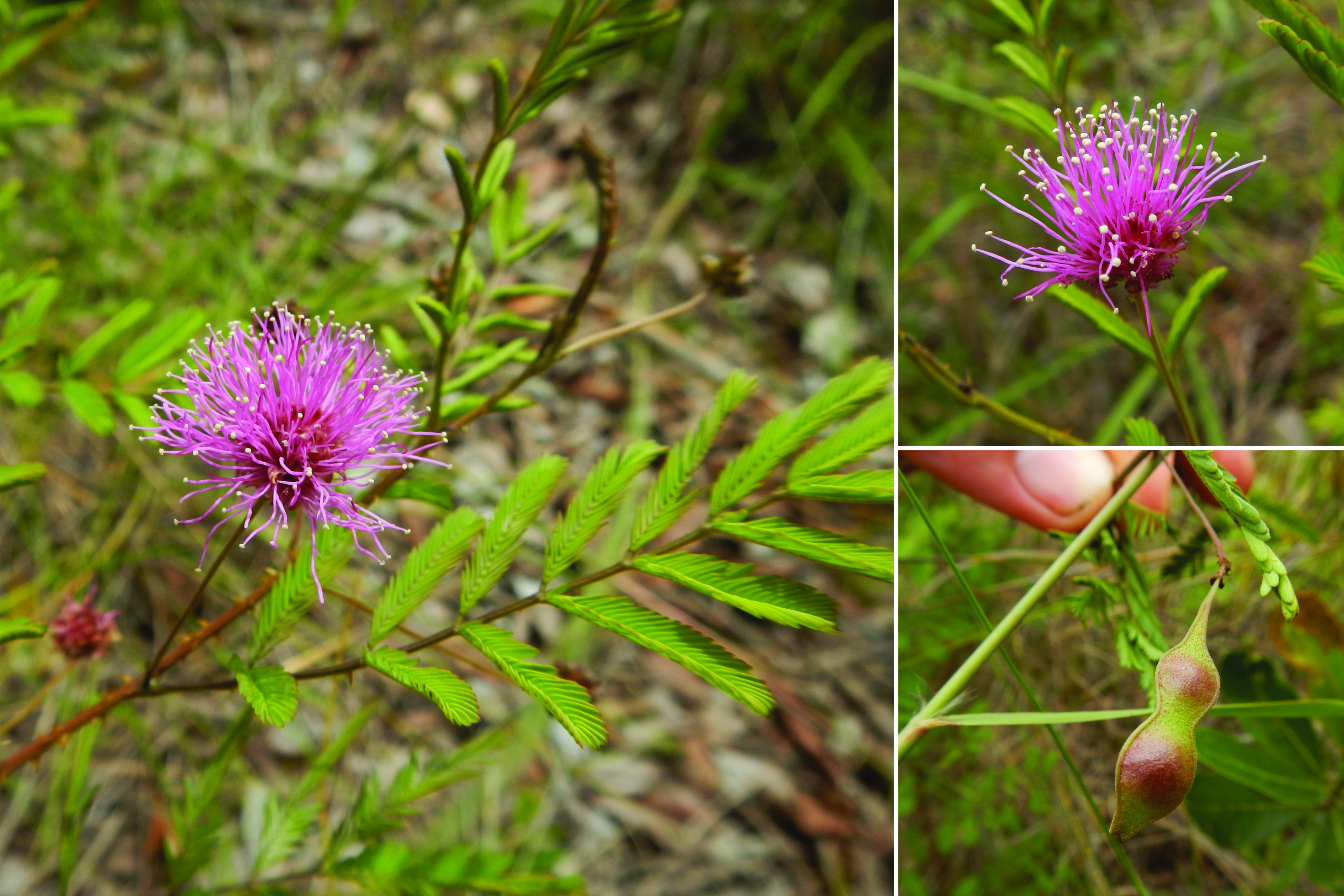 Mimosa ibityensis inflorescences and fruits; photos by E.J.M. Koenen.
Mimosa ibityensis inflorescences and fruits; photos by E.J.M. Koenen.
Koenen E.J.M. 2024. A new species of Mimosa (Leguminosae) endemic to Central Madagascar. Candollea 79: 229–234. doi: http://dx.doi.org/10.15553/c2024v792a2
A New Broom, Gonocytisus graecus, from Greece
It is relatively rare that new legume species are described from Europe these days, especially when they are conspicuous roadside shrubs with showy flowers. Nevertheless, new field and taxonomic work on the diverse and complex genera of tribe Genisteae, which are distributed in large part across the Mediterranean basin, has revealed the hitherto unknown narrowly endemic species, Gonocytisus graecus, named as such as it is endemic to Greece.
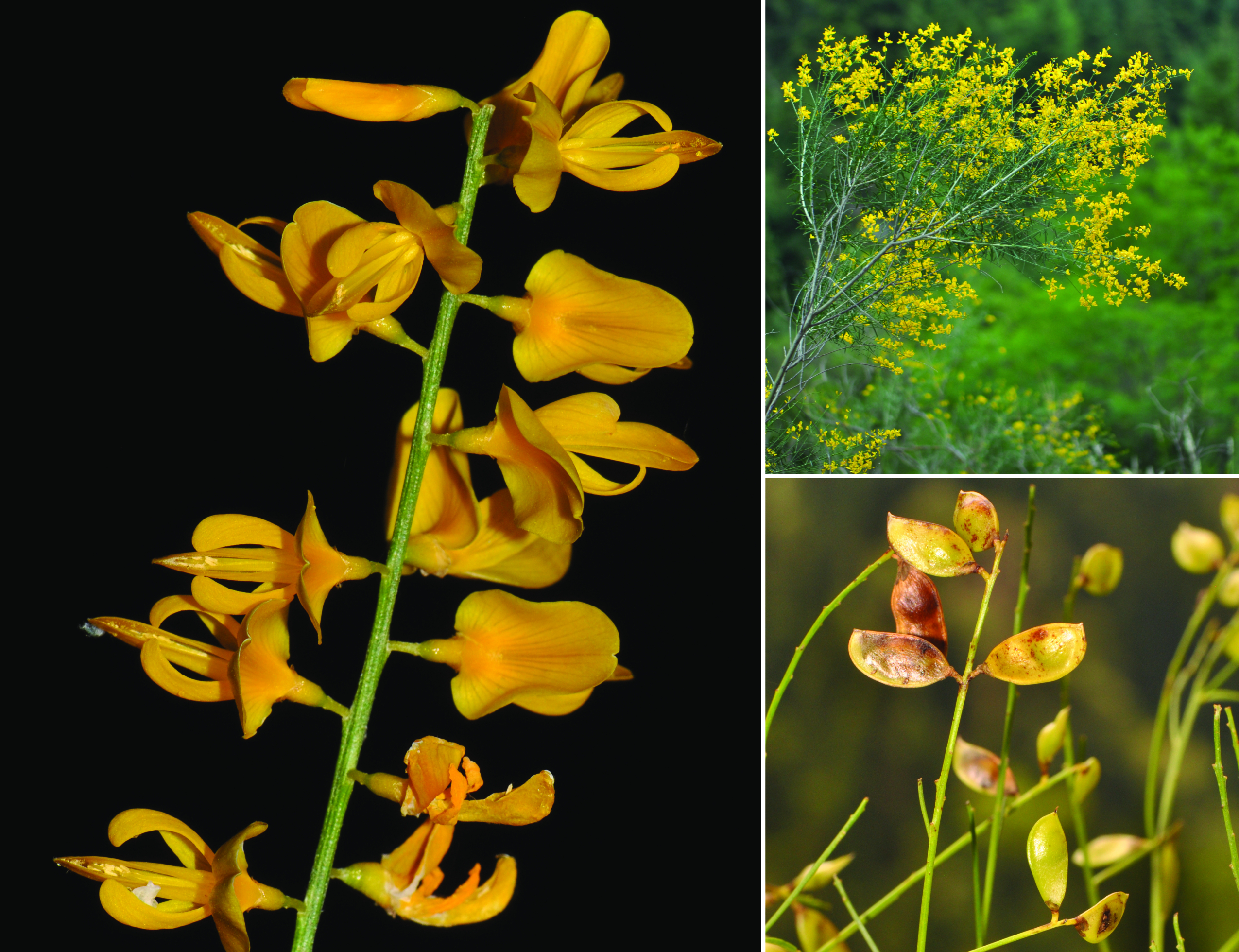 Gonocytisus graecus flowers, fruits, and habit; photos by Ozan Şentürk.
Gonocytisus graecus flowers, fruits, and habit; photos by Ozan Şentürk.
Şentürk O., Kenicer G.J. & Yildirim H. 2024. A new broom Gonocytisus graecus (Genisteae, Leguminosae/Fabaceae), from Greece. Phytotaxa 666: 277-290. https://doi.org/10.11646/phytotaxa.666.4.3
Senegalia ajaya from West Bengal, India
Senegalia ajaya, newly described from India, is a formidably armed lianescent shrub with up to six lines of prickles on the stem, plus branchlets modified into tendrils with prickles and prickles on the underside of the leaf rachis. One of the unusual distinguishing features of this species is the two types of paraphyllidia (modified, reduced leaflets) found at the base of the pinnae.
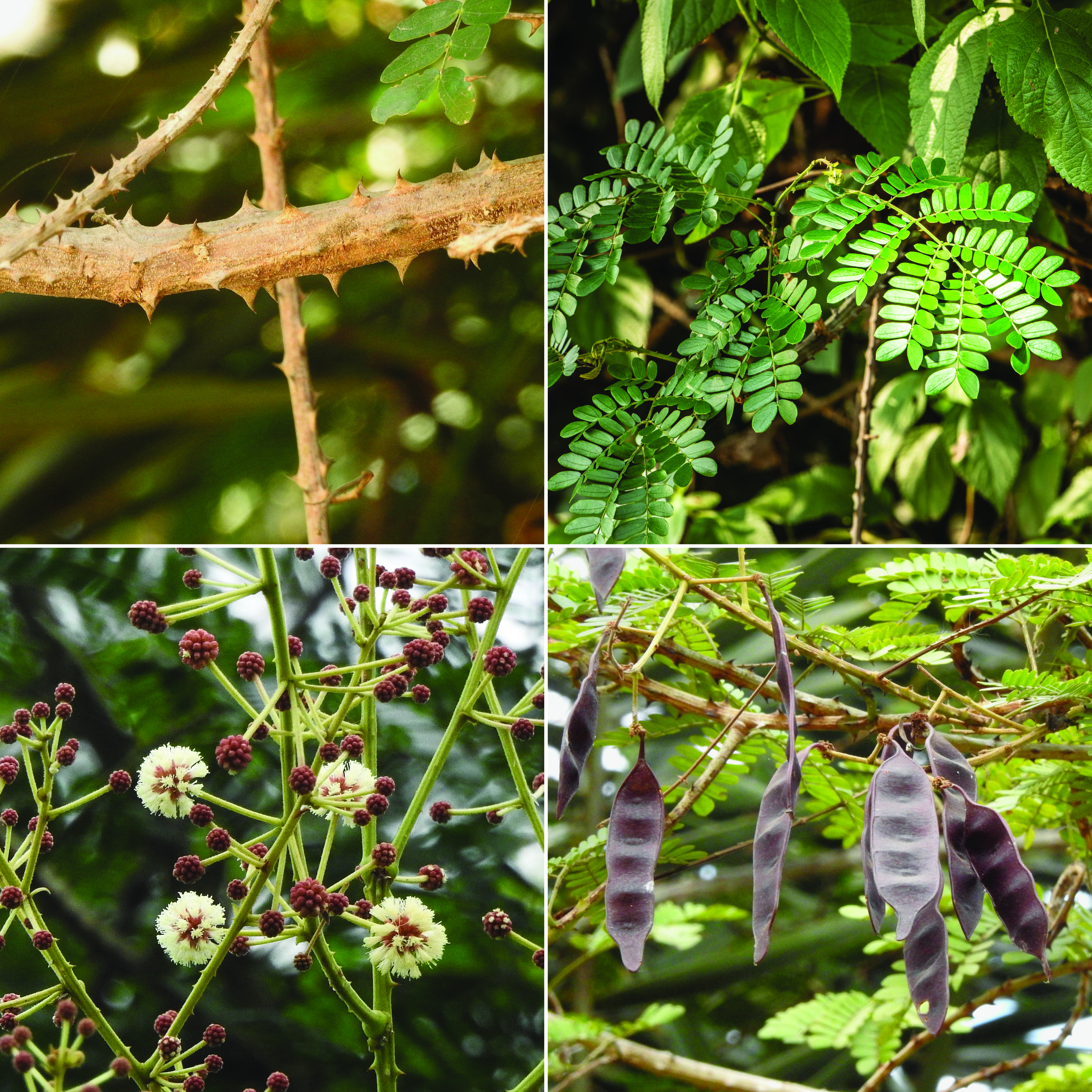 Senegalia ajaya; photos by S. Alam.
Senegalia ajaya; photos by S. Alam.
Alam S. & Lokho A. 2024. Senegalia ajaya (Mimosoid clade, Caesalpinioideae, Fabaceae), a new species from Birbhum District, West Bengal, India. Phytotaxa 668(2): 186-194. https://doi.org/10.11646/phytotaxa.668.2.7
18 Species from One Species of Pultenaea, Including 14 New Species from SE Australia
This study presents a landmark example of how detailed morphological and geographical data are providing evidence for the delimitation of sets of morphologically distinct, narrowly endemic species across physiographically and geologically diverse and complex landscapes from previously widespread polymorphic species complexes. Here, detailed morphological analysis of the Pultenaea setulosa species complex, sampling more densely than previously across the Great Dividing Range and the Blue Mountains of SE Australia, has shown that geographically discrete populations are morphologically distinct and uniform, exhibiting fixed character states, suggesting strong geographical/ecological isolation over short distances. Alongside preliminary genetic data indicating non-monophyly of the elements of the P. setulosa complex, this study provided the basis for delimiting 18 species, 14 of which are described as new. These include several species illustrated below, which are named for legume specialists: P. westonii, named for Peter Weston, P. corrickiae, named for Margaret Corrick, and P. woolcockiorum, named for Dorothy and Collin Woolcock, who authored a popular book on native peas in SE Australia.
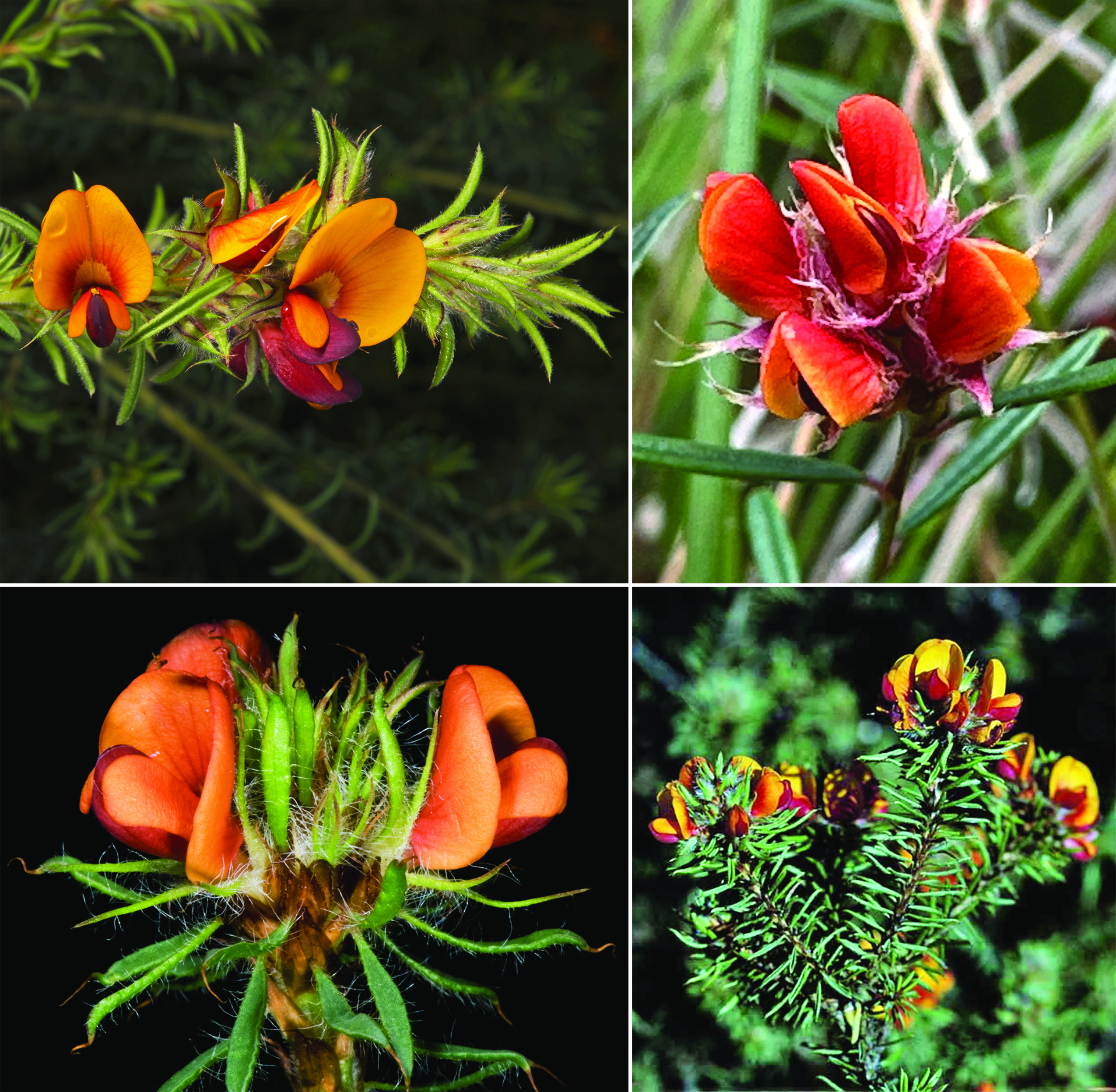 Top from the left: Pultenaea corrickiae, photo by Andrew Orme; P. rubescens, photo by Paul Rossington. Bottom from the left: P. westonii, photo by Andrew Orme; P. woolcockiorum, photo by Murray Fagg.
Top from the left: Pultenaea corrickiae, photo by Andrew Orme; P. rubescens, photo by Paul Rossington. Bottom from the left: P. westonii, photo by Andrew Orme; P. woolcockiorum, photo by Murray Fagg.
Barrett R.L. et al. 2024. Revision of the Pultenaea setulosa species complex (Fabaceae: Mirbelieae) including 14 new species. Australian Systematic Botany, 37(2): SB23014. https://doi.org/10.1071/SB23014
Barrett R.L., Clugston J.A., Jobson P.C. & Rossington P. 2024. Pultenaea rubescens (Fabaceae: Mirbelieae), a new species from north-eastern New South Wales. Telopea 27: 203-209. https://doi.org/10.7751/telopea19689
Three New Genera in the Mirbelia Clade
Alongside the ongoing inventory of species in the species-rich genus Pultenaea of the Mirbelia clade of subfamily Papilionoideae, new phylogenomic work has shown that the genus is non-monophyletic, prompting generic re-delimitation, with the reinstatement of the genus Euchilus and the circumscription of three new genera: Grievea, Jennata, and Loricobbia. As with several of the new species of Pultenaea named this year, two of these new genera are named for legume workers: Jennata for the late Jennifer (Jenny) Chappill and Loricobbia for Lorraine Cobb, who illustrated many legumes for Jenny Chappill and her students.
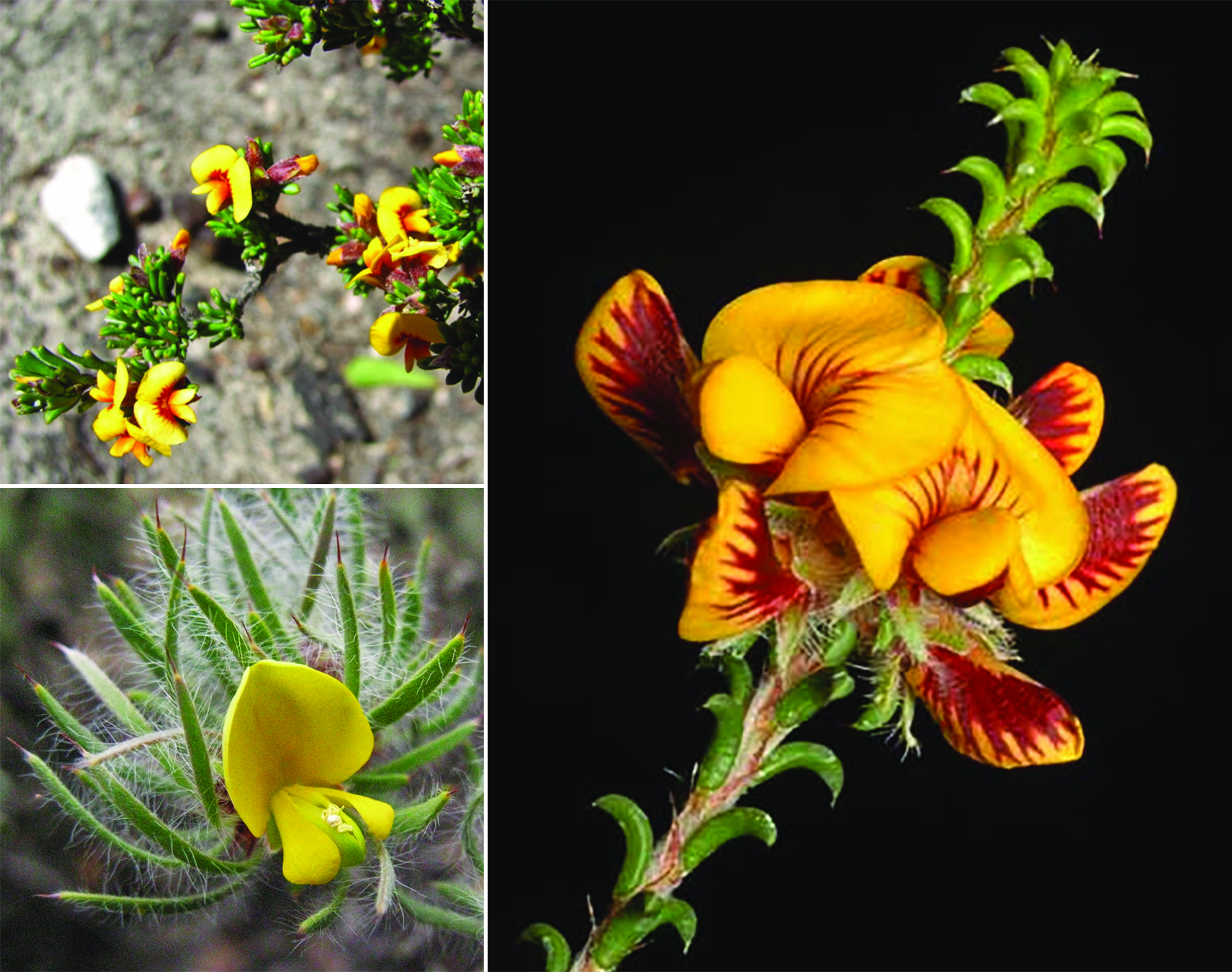 Clockwise from top left: Grievea craigiana; photo by Gillian Craig, Jennata empetrifolia; photo by Murray Fagg, Loricobbia pauciflora; photo by Terry Macfarlane.
Clockwise from top left: Grievea craigiana; photo by Gillian Craig, Jennata empetrifolia; photo by Murray Fagg, Loricobbia pauciflora; photo by Terry Macfarlane.
Barrett R.L., Clugston J.A., Orthia L.A., Cook L.G., Crisp M.D., Lepschi B.J., Macfarlane T.D., Weston P.H. & Wilkins C.F. 2024. East rarely meets West: a revised delimitation for Pultenaea (Fabaceae: Mirbelieae) with reinstatement of Euchilus and three new genera from south-west Western Australia. Australian Systematic Botany 37(5), SB23029. https://doi.org/10.1071/SB23029
Upranking Infraspecific Varieties of Libidibia ferrea as Species
Detailed morphometric and ecogeographical studies of widespread polymorphic species can often provide evidence for upranking infraspecific taxa as distinct species. Recognition as species, as well as reflecting morphological distinctiveness, also means that important diversity is properly recognized in conservation, given that infraspecific taxa are rarely accounted for or are down-weighted in conservation assessment. Morphometric analysis and ecological niche modeling across the widespread South American species Libidibia ferrea (Caesalpinioideae), the iconic Brazilian ‘pau ferro’, or iron tree, so-called because of its hard, dense wood, revealed four distinct morphotypes with distinctive ecogeographic distributions. These results provided the basis for the recognition of four distinct species: Libidibia ferrea, L. juca, L. leiostachya, and L. parvifolia.
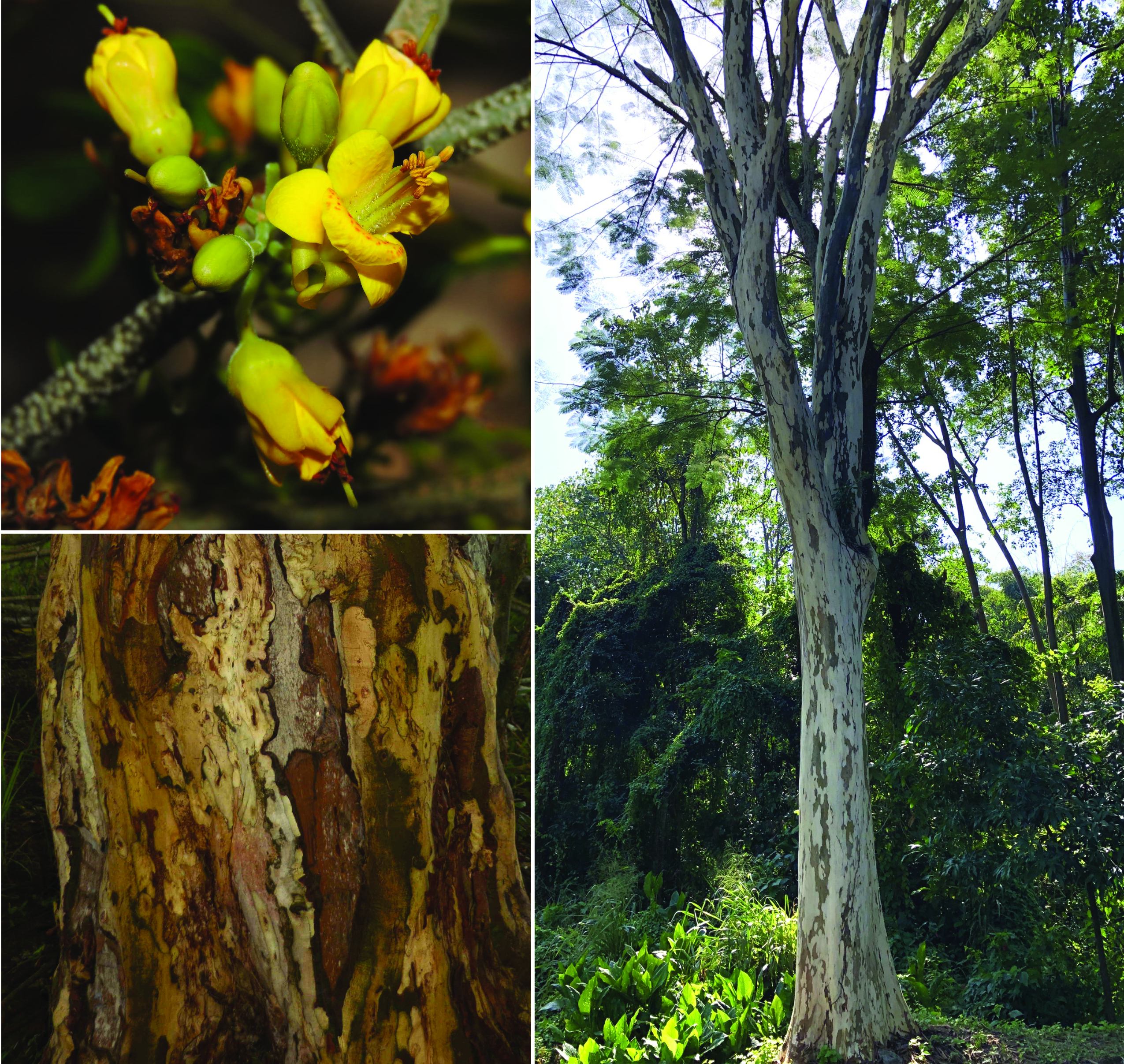 Clockwise from top left: Flowers of Libidibia juca; photos by R. Queiroz, tree habit of L. leiostachya; photo by J. Moreno, snake-bark of L. parvifolia; photo by L. Queiroz.
Clockwise from top left: Flowers of Libidibia juca; photos by R. Queiroz, tree habit of L. leiostachya; photo by J. Moreno, snake-bark of L. parvifolia; photo by L. Queiroz.
Oliveira F.G., Santos F.D.S., Lewis G.P., de Oliveira R.P. & de Queiroz L.P. 2024. Reassessing the taxonomy of the Libidibia ferrea complex, the iconic Brazilian tree “pau-ferro” using morphometrics and ecological niche modeling. Brazilian Journal of Botany: 1-17. https://link.springer.com/article/10.1007/s40415-024-01011-0
Two New Species of Brachypterum in Australia
Molecular phylogenies and a revision of the Millettioid genera Derris and Brachypterum in Australia have demonstrated robust support for these two genera, and for two new species of Brachypterum, both endemic to northern Queensland, Australia. These new species are slender twining vines or lianas in various tropical forest types.
 Top left: Brachypterum nitidum. Bottom left and Right: B. opacum. Photos: Rigel Jensen (left), Andrew Ford (right).
Top left: Brachypterum nitidum. Bottom left and Right: B. opacum. Photos: Rigel Jensen (left), Andrew Ford (right).
Cooper W.E., Zich F.A., Nauheimer L., Harrison M.J. & Crayn D.M. 2024. A revision of Derris and Brachypterum (Leguminosae subfamily Papilionoideae) in Australia. Australian Systematic Botany 37: SB23030. https://doi.org/10.1071/SB23030
Further Additions to the Hyper-Diverse Greater Cape Flora—Five New Species of Aspalathus
The description of five new species of Aspalathus emphasizes the importance and value of fieldwork. This is true even in areas like the Greater Cape Floristic Region of southern Africa, where the flora is generally already reasonably well-documented. As the authors note, new fieldwork is especially important to discover cryptic and short-lived, post-fire species and narrowly restricted endemics, which have frequently been overlooked. All five of these new species have highly restricted distributions; several of them are threatened. On the plus side, fieldwork can also rediscover populations of species thought to be extinct. Three such recently rediscovered species of Aspalathus are documented here alongside the five novelties.
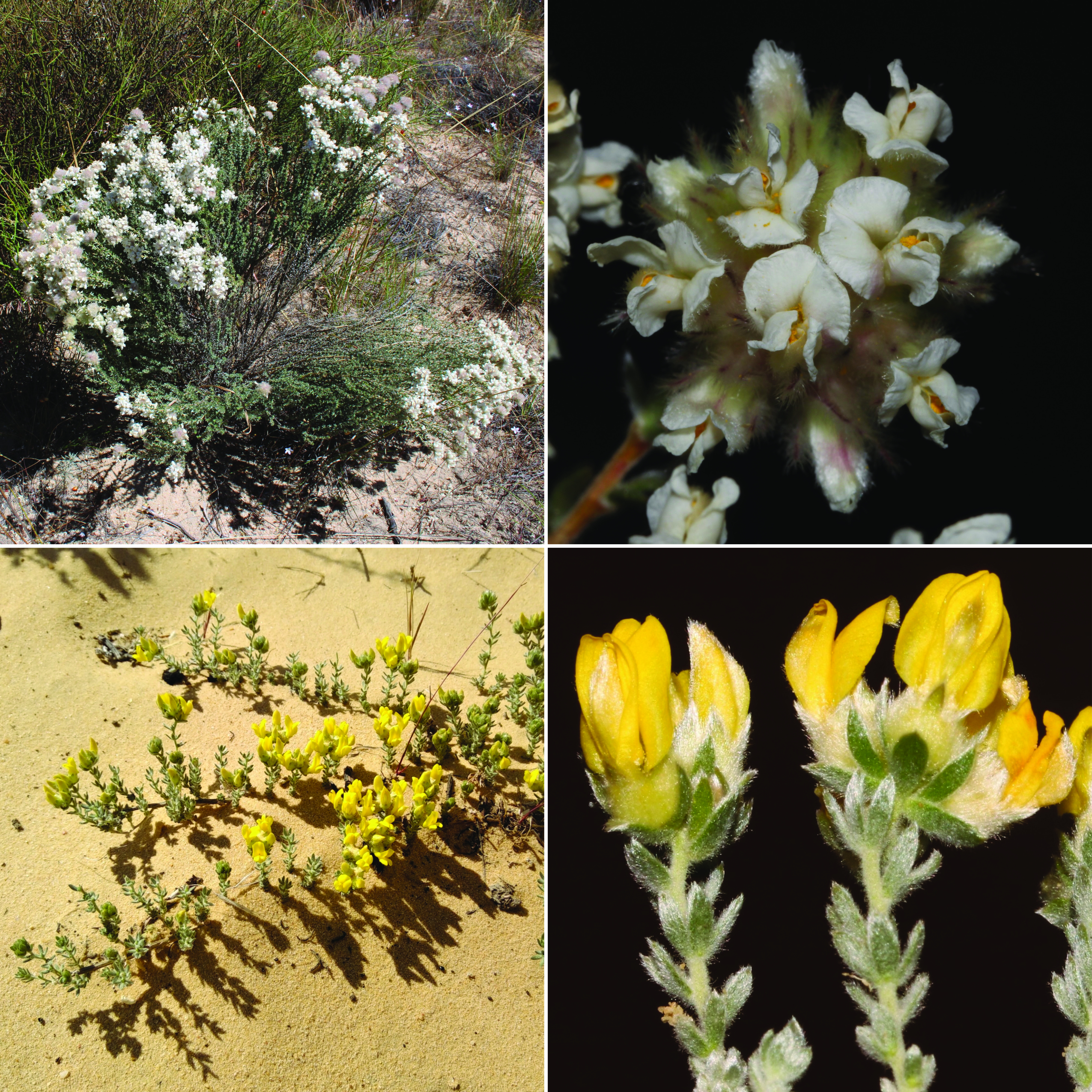 Top: Aspalathus albicephala, Bottom: A. jardinii. All photos by Brian du Preez.
Top: Aspalathus albicephala, Bottom: A. jardinii. All photos by Brian du Preez.
Du Preez B. & Stirton C.H. 2024. Four new species of Aspalathus (Fabaceae, Crotalarieae) and notes on three rediscovered species from the Greater Cape Floristic Region. South African Journal of Botany 166: 169-180. https://doi.org/10.1016/j.sajb.2024.01.010
Stirton C.H., Du Preez B., Helme N. & Musaya M. 2024. A new species of Aspalathus (Fabaceae, Crotalarieae) from the Cape Floristic Region, South Africa. Phytotaxa 665: 69-74. https://doi.org/10.11646/phytotaxa.665.1.8
A New Cliff-Dwelling Hedysarum from the Remote Qilianshan Mountains
There are more than 160 species of Hedysarum across north temperate Asia, Europe, northern Africa, and North America. The Qinghai-Tibetan Plateau is one of the centers of diversity for the genus, with 24 species, 22 of which are endemic there. The newly described Hedysarum qilianshanense is narrowly endemic to a remote valley in the magnificent Qilianshan Mountains on the northern border of the Qinghai-Tibetan Plateau. It grows on stony slopes and rock cliffs at elevations of 2000–3000 m.
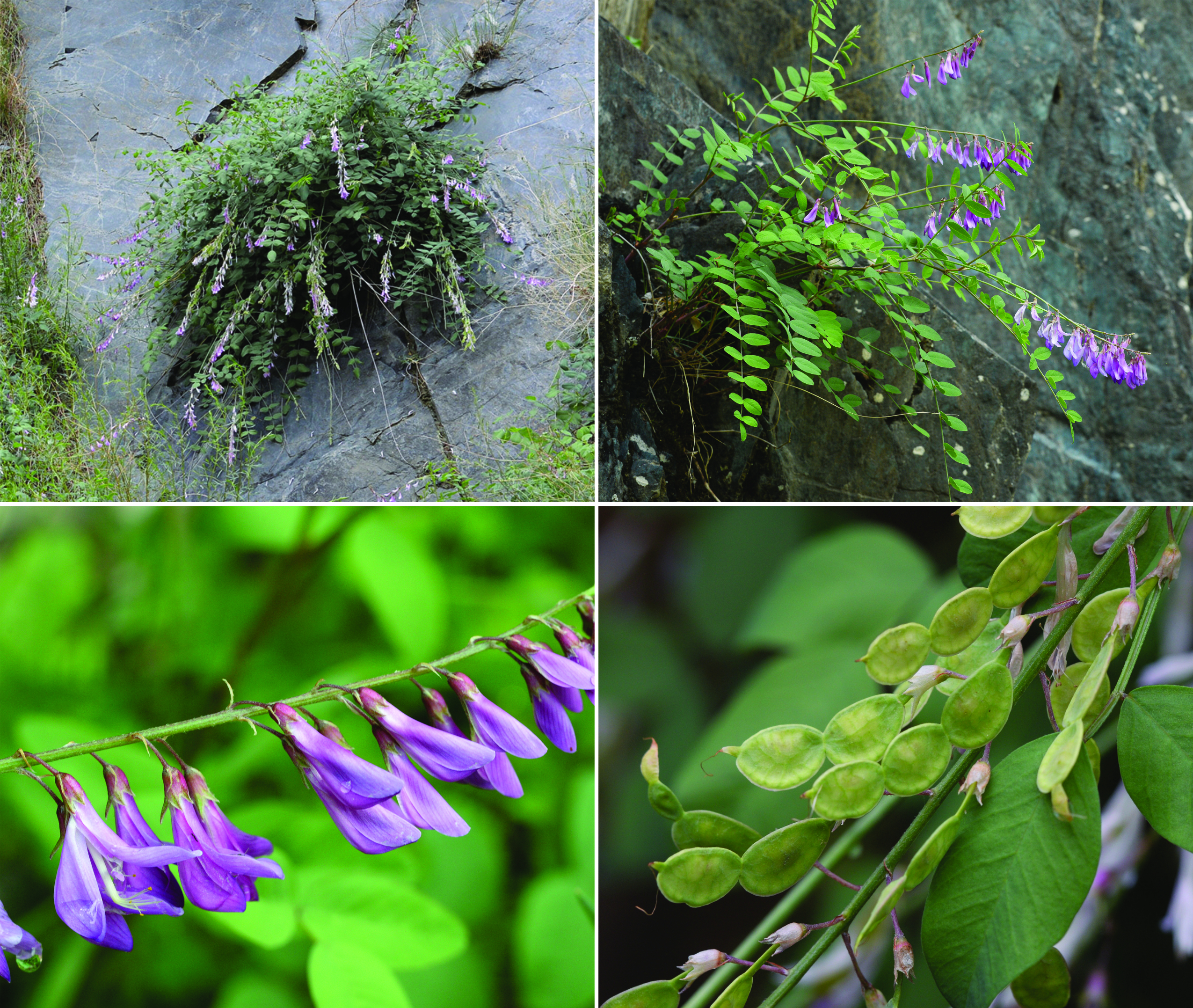 Hedysarum qilianshanense; photos Pei-Liang Liu.
Hedysarum qilianshanense; photos Pei-Liang Liu.
Pei-Liang Liu et al., 2024. Hedysarum qilianshanense sp. nov. (Fabaceae, Hedysareae), a new species from the Qilianshan Mountains in Gansu, China. PhytoKeys 237: 103-106. DOI: 10.3897/phytokeys.237.116236
The genus Astragalus just keeps on growing
With more than 3,000 species, the genus Astragalus is the most species-rich legume genus, indeed the most species-rich genus of flowering plants. Every year, in recent years, a clutch of new Astragalus species is added, reflecting the fact that the majority of newly described species belong in species-rich genera. Illustrated here are two of the 2024 Astragalus additions from Turkey and Pakistan.
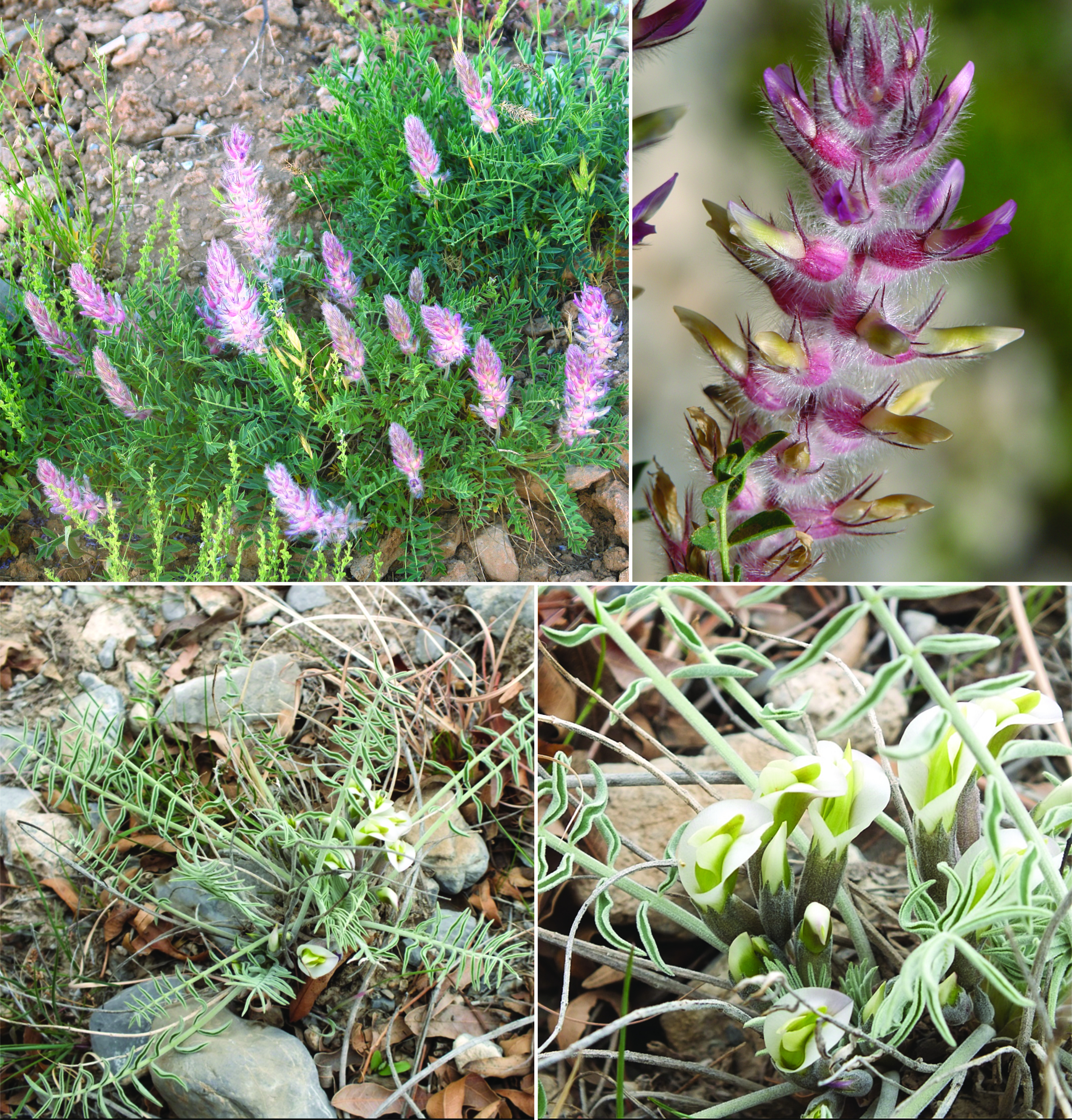 Astragalus miksensis (top); photos M. First, A. quettensis (bottom); photos Amjad Khan.
Astragalus miksensis (top); photos M. First, A. quettensis (bottom); photos Amjad Khan.
Firat M. 2024. Astragalus miksensis Fırat (Fabaceae), a new species in section Hymenostegis from Van province, Türkiye. Phytotaxa 641:149-160. https://orcid.org/0000-0001-5814-614X
Ke Z.W., Yu K. & Gan Q.L. 2024. Astragalus duheyuanensis (Fabaceae), a new species from central China. Annales Botanici Fennici 61: 1-5. <https://doi.org/10.5735/085.061.0101
Khan A., Sultan A., Maassoumi Ashghar & Mumtaz A.S. 2024. Astragalus quettensis (Galegeae—Fabaceae), a new species of section Pendulina from Pakistan. Phytotaxa 636: 1-19. https://doi.org/10.11646/phytotaxa.636.1.1
Pourebrahim S., Kazempour-Osaloo S. & Maassoumi A.A. 2024. Contributions to Astragalus sect. Dissitiflori in the light of morphological and molecular evidence: a new species and a new resurrect. Phytotaxa 668: 239-251. https://doi.org/10.11646/phytotaxa.668.3.3
Yang Z.Z., Liu Q.R., Liu Z., Xiang J.S. & Li X.L. 2024. Astragalus liuaiminii, a new species of Astragalus (Fabaceae) from Xinjiang, China. PhytoKeys 243: 209-214. https://doi.org/10.3897/phytokeys.243.119707
Three new unifoliolate-leaved lupin species from Florida, U.S.A.
Dense sampling of species and intraspecific diversity in molecular phylogenies often reveals cryptic taxa, as seen here in Lupinus from Florida. RADseq data for 106 accessions of unifoliolate Lupinus from Florida, U.S.A revealed a set of eight subclades or genetic variants that are allopatrically distributed across the fragmented geographical distribution of the genus on the Florida sand ridges. These genetic variants correspond with quantitative morphological differences between these subclades. These results provided the basis for recognition of three new species and confirmed the distinction of two narrowly restricted, critically endangered sand ridge endemics, L. westianus and L. aridorum, which had previously been treated as conspecific or as intraspecific varieties. The recent Pleistocene ages of these taxa suggest that the relatively modest degrees of geographical isolation over short time spans can promote species divergence. The Florida clade of Lupinus is unusual in having unifoliolate leaves, which have evolved independently in Florida and eastern South America from digitate leaves which are found in the majority of Lupinus species.
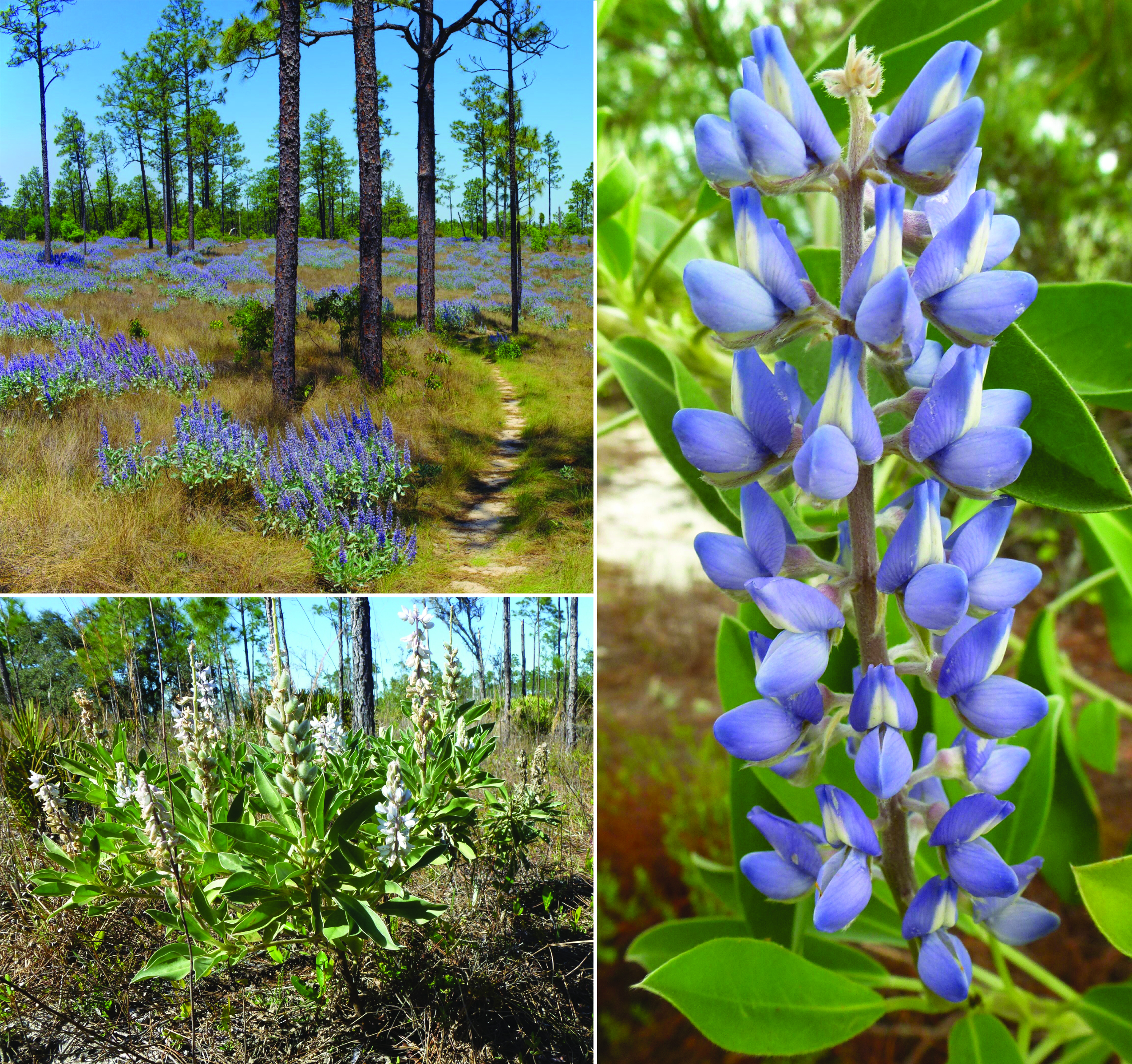 Lupinus westianus in the pine barrens of the Florida panhandle (top left) and Lupinus floridanus (bottom left and right); photos Floyd Griffiths (top left); Edwin Bridges (bottom left and right).
Lupinus westianus in the pine barrens of the Florida panhandle (top left) and Lupinus floridanus (bottom left and right); photos Floyd Griffiths (top left); Edwin Bridges (bottom left and right).
Bridges E.L. & S.L. Orzell. 2024. Systematics of the unifoliolate Floridian Lupinus clade (Leguminosae: Papilionoideae). Phytoneuron 2024-04: 1–61. ISSN 2153 733X.
Nevado B., Atchison G.W., Bridges E.L., Orzell S., Filatov D. & Hughes C.E. 2024. Pleistocene diversification of unifoliolate‐leaved Lupinus (Leguminosae: Papilionoideae) in Florida. Molecular Ecology 33: p.e17232.
Eleven new species of Indigofera
Following close on the heels of the 18 new species of Indigofera described from the Cape Floristic Region of southern Africa in 2023, this year saw an additional 11 species described from that same region, spearheaded by Brian du Preez and Brian Schrire.
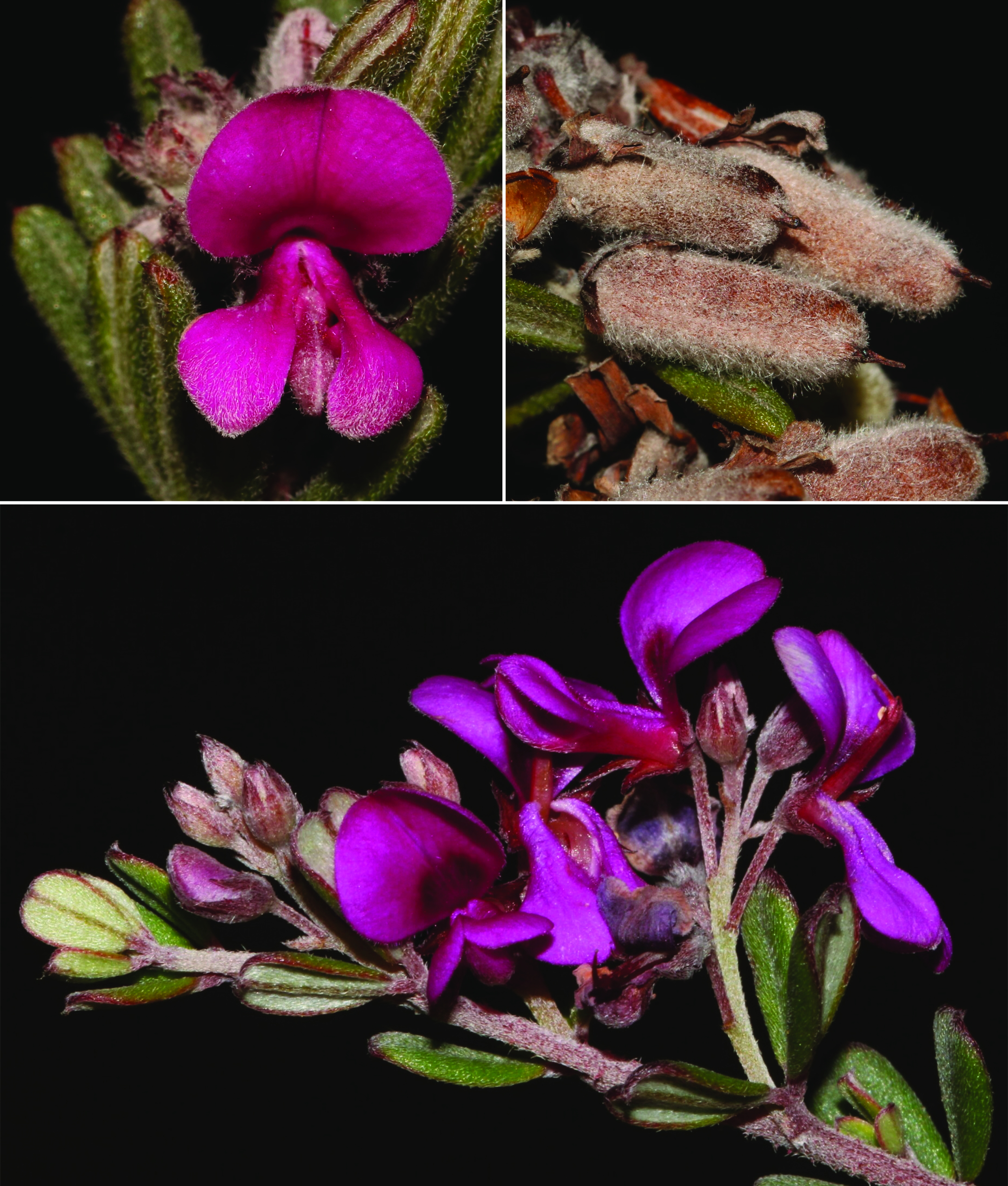 Top: Indigofera rhodantha flowers and fruits; bottom: I. vlokii habit and flowers; all photos Brian du Preez.
Top: Indigofera rhodantha flowers and fruits; bottom: I. vlokii habit and flowers; all photos Brian du Preez.
du Preez B., Schrire B.D., Dreyer L.D., Stirton C.H. & Muasya A.M. 2024. Revision of Indigofera L. sect. Brachypodae subsect. Brachypodae (Fabaceae: Indigofereae) from the Greater Cape Floristic Region. South African Journal of Botany 166: 226-258. https://doi.org/10.1016/j.sajb.2024.01.025
A sky-blue flowered Collaea (Papilionoideae) from South Brazil
Species of Collaea (tribe Diocleae) have spectacular showy flowers suggesting potential as ornamental plants, and a new species, C. caerulea, described this year from southern Brazil is no exception. This new Collaea has beautiful, brightly coloured, bluish-lilac flowers which are the basis for the species epithet caerulea (from the Latin caeruleus = coloured sky-blue). Like many newly described species of the modern era, C. caerulea is a highly restricted endemic found at just two nearby localities in mixed Araucaria forest at mid-elevations in Santa Catarina State in southern Brazil; an IUCN threat category of Critically Endangered was proposed by the authors.
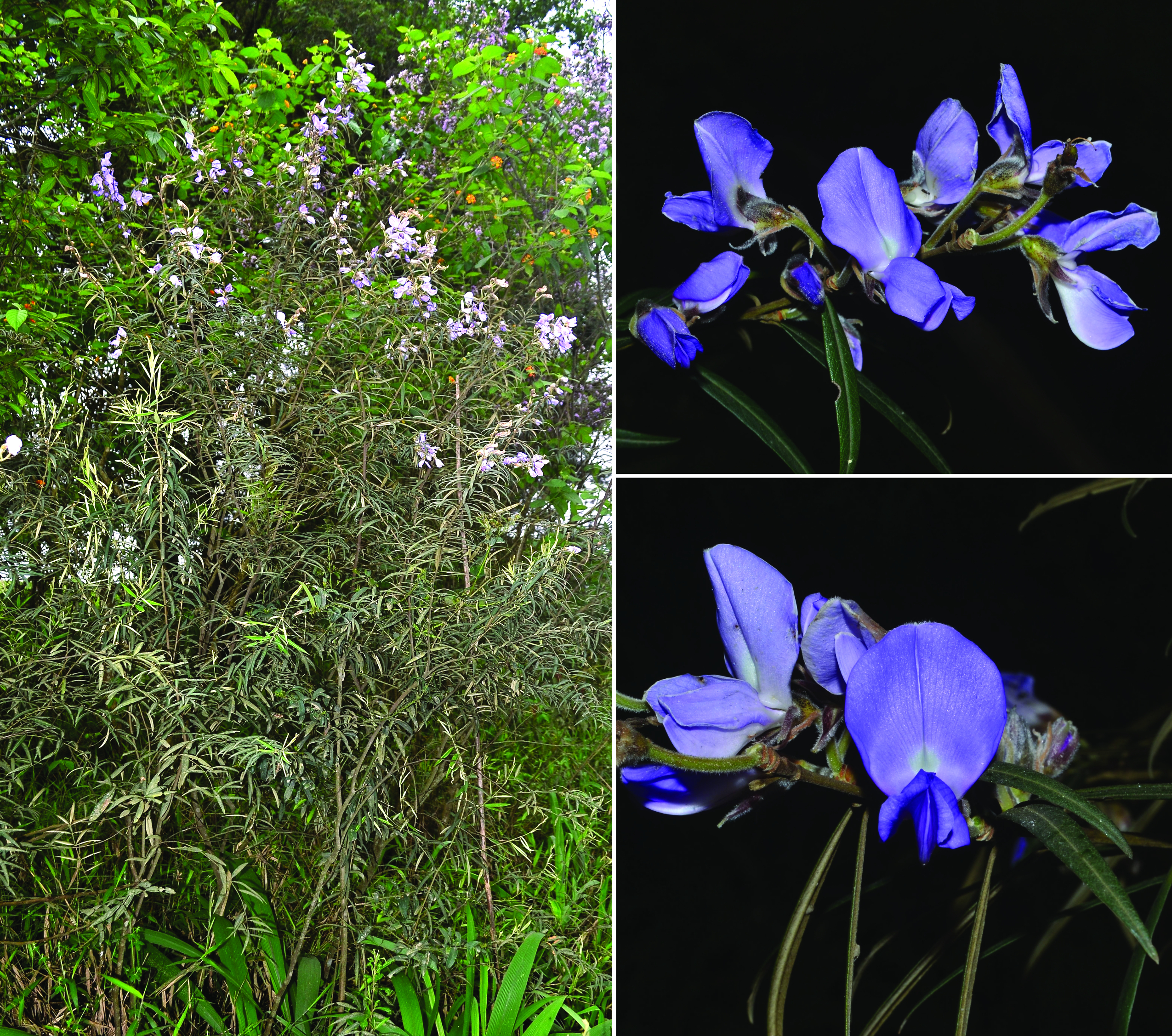 Collaea caerulea habit and flowers; photos Paulo Schwirkowski.
Collaea caerulea habit and flowers; photos Paulo Schwirkowski.
da Silva Oliveira A.C., Snak C., Schwirkowski P. & de Queiroz L.P. 2024. A new species of Collaea (Leguminosae, Papilionoideae) from South Brazil. Brittonia 1-7. https://doi.org/10.1007/s12228-023-09772-w
Ten new species of South African fountainbush
The genus Psoralea, known as fountainbush in South Africa, has around 129 species, ten of them newly described this year. These new species, all of them restricted to South Africa, arise from expanded fieldwork into previously under-collected areas, as well as from refinements to species delimitations in the leafless ‘aphylla’ and pinnately-leaved species complexes. Publication of these ten new species results from an ongoing project on the taxonomy, biogeography, and evolution of Psoralea. A further ten undescribed species are in the pipeline.
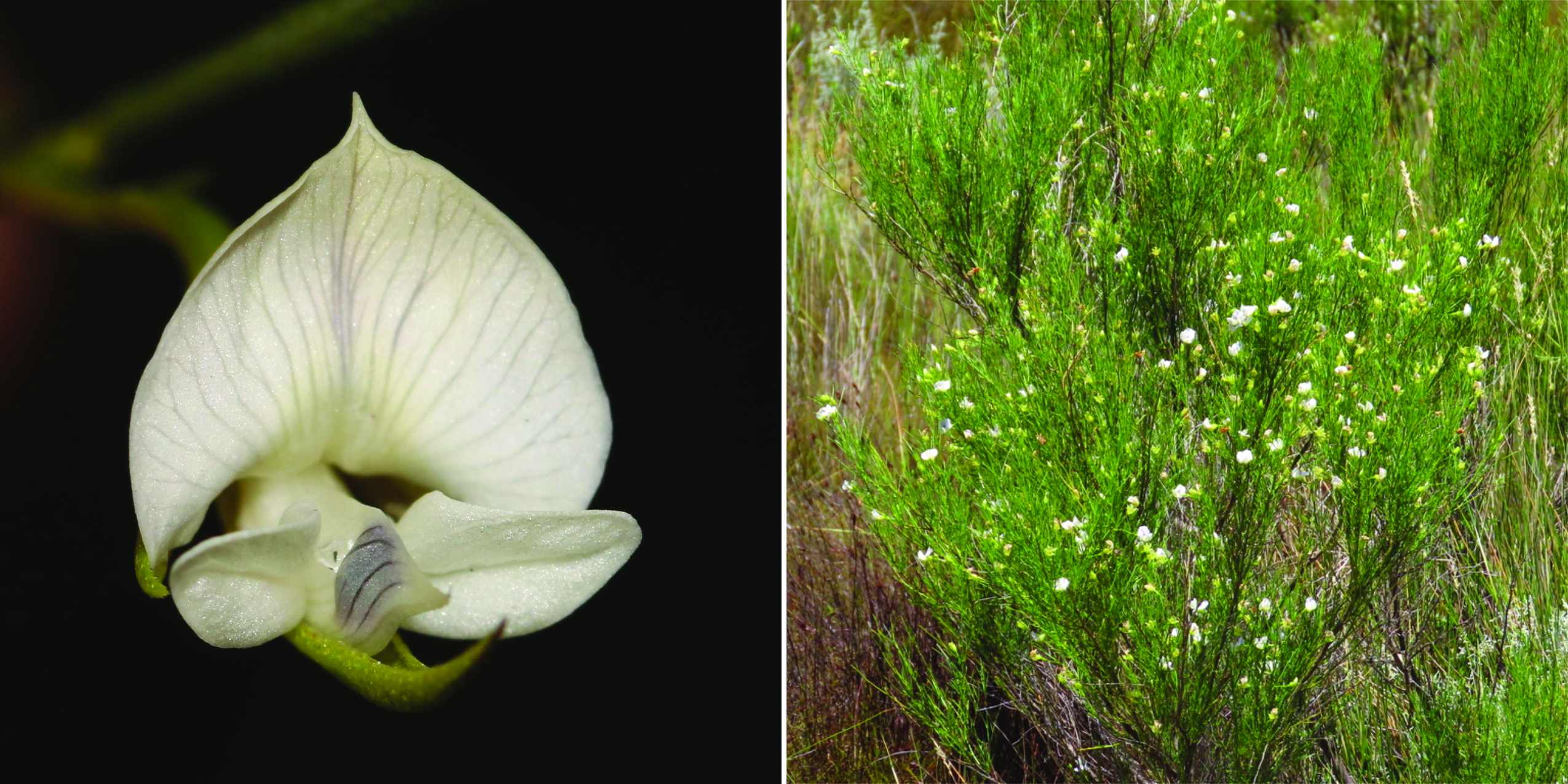 Left: Psoralea vlokii; photo Brian du Preez, right: P. oreopola; photo Fiona Hellmann
Left: Psoralea vlokii; photo Brian du Preez, right: P. oreopola; photo Fiona Hellmann
Stirton C.H., Bello A. & Muasya A.M. 2024. Ten new species and notes on the genus Psoralea L. (Psoraleeae, Fabaceae) from South Africa. Plant Ecology and Evolution 157: 291-312. https://doi.org/10.5091/plecevo.120171